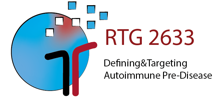Natalia Zappe
Impact of glycosylation on IgG3-induced signaling in neutrophiles
Epidermolysis bullosa aquisita (EBA) is an autoimmune, subepidermal blistering disease which belongs to the group of pemphigoid diseases. The underlying pathomechanism is the binding of autoantibodies (mainly IgG) to collagen type VII, a major component of the anchoring fibrils of the dermal-epidermal junction (DEJ). The formation of the immune complex (IC) leads to activation of immune cells, especially neutrophils resulting in the release of reactive oxygen species (ROS) and proteases. This directly contributes to split formation in the DEJ. Importantly, not all ICs activate the neutrophils in the same way. The affinity is modulated by subclass and glycosylation pattern of the IgG antibodies.
Therefore, the overarching goal of the project is to identify kinase signatures and cellular functions in neutrophils activated with different IgG subclasses containing different glycoforms. Specifically, my project aims to investigate the function of differentially glycosylated IgG3 ICs.

- People
- Doctoral Candidates
- Merabell Adem
- Katja Adriany
- Farbod Bahreini
- Estelle Bergmann
- Swayanka Biswas
- Jana Buhre
- David De Luca Laredo
- Kaan Ersoy
- Ferdinand Gebauer
- Sen Guo
- Veronika Hartmann
- Michelle Hein
- Luise Janusch
- Maj Jäpel
- Anna Knauer
- Valentin Kneitz
- Maximilian Lahmer
- Wing Yu Lee
- Daniel Mehlberg
- Sahar Mehrabani
- Afsaneh Mehrpouyan
- Sadegh Mousavi
- Milica Novovic
- Justus Ohmes
- Bianca Opelka
- Colin Osterloh
- Cristian Papara
- Tina Rastegar Lari
- Rochi Saurabh
- Alessia Maria Sbaraglia
- Jovan Schanzenbacher
- Mareile Schlotfeldt
- Carolin Schmidt
- Solveig Lea Schmidt
- Leon Schmidt-Jiménez
- Nora Schoell
- Salomini Sinnathurai
- Sarah Stenger
- Chiara Walczyk
- Nele Wellbrock
- Julia Wimmer-Gross
- Natalia Zappe
- Jianrui Zheng
- Luca Zillikens
- Carla Zünkeler
- Principal Investigators
- Associated Scientists
- Administration
- Doctoral Candidates




